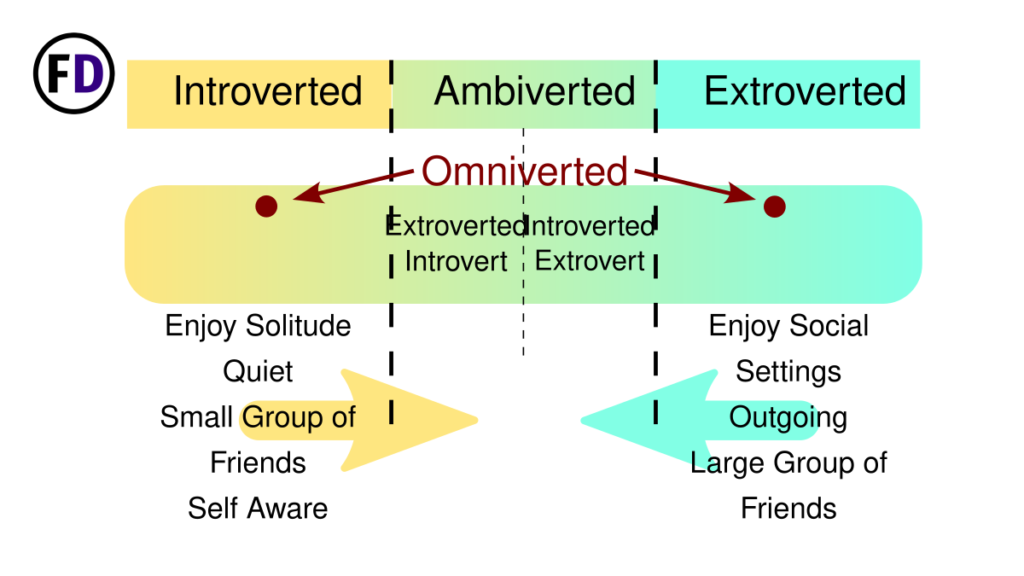Either end of the extroversion scale is pretty simple, but when you reach the middle, things get more complicated, omniverts, ambiverts, introverted extroverts, and extroverted introverts. Trying to get your head around them all can be a challenge. Understanding the difference between omniverts vs. ambiverts is an essential first step.
For anyone wanting to make progress in life or push themselves to do challenging things and reap the rewards by facing dragons, a clear understanding of personality is a great help. The Chinese proverb “Know yourself and know your enemy and you won’t lose a hundred battles.” is true.
Ambiverts vs. Omniverts (and How They Differ from Other Personalities)

Everyone understands the difference between an introvert and an extrovert. One is the quiet guy in the corner who’d rather be at home reading, while the other is the center of attention who always needs people around her.
Extroversion isn’t a binary choice, however, instead, it’s a scale that goes from highly extroverted to highly introverted.
Few people are at the extreme ends of this scale; Adam Grant, an organizational psychologist, suggests that between 50-66% of people are ambiverts. So new categories evolved to understand the different personality types between the two extremes. Four of them:
Want to figure out which you are? You can take Grant’s personality test or keep reading for a clearer understanding.
Why You Must Understand Personality Types
Not everyone requires a deep understanding of personality types and how different personalities act, but everyone should at least understand their own type. Even if it just means your Myers Briggs type vs. your Jungian archetype vs. your big five personality type.
Knowing your personality, what motivates you, and how you react in different situations is critical to understanding yourself and building a fulfilling life. In addition, it’s crucial in changing your behavior, choosing the right job, and even finding a suitable partner.
Understanding others is also a great boon, especially when you have to work or live with them every day. The first step is figuring out where they land on the extraversion scale.
- Better communication
- Improved relationships – understanding fosters empathy
- Improved leadership and management skills
- Become a better team member
What is an Omnivert?
Omnes is the Latin word for ‘all’ or ‘both,’ so an omnivert is both introverted and extroverted. That doesn’t mean that they have multiple personalities or that they simply have traits from both sides of the spectrum; omniverts are a little different than most people imagine.
Most omniverts don’t sit in the middle of the spectrum; instead, they jump from one side to the other. Sometimes they land in the middle of the extrovert side, while others are entirely introverted. See, they really are both.
Common Characteristics
It can be challenging to tell an omnivert apart from other people at first if you only spend a small amount of time with them. They may seem like regular extroverts, the life of the party and chatting with everyone. However, the next time you meet them, it might be a different story, they stand alone, and when you approach, the conversation doesn’t flow. You might think they don’t like you, but that’s not it. You’ve just met an omnivert.
These common omnivert traits can make them easier to spot:
- Their inner extrovert shines when with introverts
- They’re introverted when with extroverted people
- They take personality tests, but the results are different every time
- After heavy social interactions, they need time to recharge
- They are great communicators and listeners
Strengths and Weaknesses
The ultimate strength of an omnivert is their ability to adapt to different social situations. They are both fully extroverted and fully introverted, which gives them a huge advantage when dealing with different types of people. They can “turn it up” when the environment requires it, such as when selling or speaking in front of a crowd. But also tone it down and become a great listener and mentor with the focus of an introvert.
Unfortunately, the omnivert’s biggest strength is also his biggest weakness. He might not always be able to decide where he lands at any given time. So when a large gathering requiring an outspoken leader arises, he might be unable to do the job if he’s in introvert mode.
Celebrity Examples of Omniverts
Eminem is the best example of an omnivert. When he’s on stage, he is entirely extroverted, more so than many pure extroverts, but you may have seen him in interviews where he seems quiet and introspective. His introverted side probably allows him the space and focus to write so prolifically, while the outgoing side is the performer and entertainer.
Taylor Swift has a very outgoing and bubbly side to her personality; again, that’s the performer in her. But she had also spoken of her introverted tendencies, sometimes even spending months in relative isolation from the spotlight to write and make music like when she made “Folklore.”
What Is an Ambivert?
Like an omnivert, an ambivert doesn’t fit easily into traditional personality roles. But an ambivert doesn’t jump from one side to the other like an omnivert; instead, ambiverts are the people who live in the very center of the scale. Neither introvert nor extrovert – ambiverts have personality traits of both.
Common Characteristics
Individual ambiverts may have differing characteristics from either side of the extroversion scale, but they all have a few things in common.
- Neither the life of the party nor the awkward bystander
- Likable, they get on with everyone
- Ambiverts are introspective
- Strong social skills; they adapt to the situation
Strengths and Weaknesses
Ambiverts are like social chameleons; they can judge the social landscape and adapt. They’re never dominating or trying to control the conversation but aren’t afraid to say their piece. This makes them valued team members who are always included, similar to a delta male or beta male; they aren’t a challenge to the leaders and also put in good work.
Some ambiverts can come across as boring, however, especially if they don’t let their extroverted side loose occasionally. Ambiverts are also likely to need time to recharge after social situations, and they may burn out if they don’t get it.
Celebrity Examples of Ambiverts
Barack Obama is an excellent example of an ambivert. Even when speaking, which he does masterfully, he doesn’t seem very extroverted. Instead, his slow and deliberate delivery is that of a skilled introvert, thoughtful and well-informed, precisely what you’d expect from an ambivert.
Omnivert vs. Ambivert: The Differences
- Omniverts jump from extroverted to introverted. Ambiverts stay in the middle.
- Omniverts can be entirely extroverted (or introverted) at times. Ambiverts are always a mixture of both.
- Ambiverts have more control over their personality; omniverts may find themselves in “intorvert mode” even when they don’t want to be.
- Ambiverts have a more consistent personality. Omniverts may seem to peak and crash to outsiders.
Ambiverts vs. Omniverts: The Similarities
- Both omniverts and ambiverts need time to recharge after intense social interactions.
- They are both excellent communicators with adaptable styles.
- Both are readily accepted by individuals and groups.
- They both straddle introversion and extroversion and may prefer one or the other.
Omniverts, Ambiverts, the MBTI, and Other Personality Tests
The Myers-Briggs Type Indicator tests people depending on four personality traits or scales to evaluate their personality
- Introversion or Extraversion
- Sensing or Intuition
- Thinking or Feeling
- Judging Perceiving
From these four personality spectrums, results a letter so you might be INTJ, for example. Omniverts will experience changes in their first letter, either an I or an E. This reflects their shifting between being introverted and extroverted.
On the other hand, an ambivert won’t experience changes in their first letter, but they might find some of the personality test questions challenging when they ask about your place on the extroversion scale.
The Big Five Personality Test, as the name suggests, tests you along five spectrums:
- Extroversion
- Agreeableness
- Conscientiousness
- Openness
- Neuroticism
This test is often seen as more scientific, and so it is more likely to pick up on your ambiversion or omniversion than the MBTI. specifically, omniverts may gain points in agreeableness and openness (and obviously extroversion) when they are in extrovert mode.
Embrace Your Personality Type and Let Others Be There’s
Understanding your personality type, where you lie on the extroversion scale, and where you stand on the socio-sexual hierarchy will make you more self-aware. You’ll know why you act and think in the way you do. Why certain things excite you while others turn you off, and you’ll better understand the types of people you’re most likely to get along with. For example, a close friendship with an extrovert will be very challenging if you’re highly introverted.
So it’s important not to fight against your personality, which means a job that suits your personality will make life easier. And a partner with a similar character might make for a more straightforward relationship. And in the times when personality types don’t align, you’ll understand the differences between you.
While you shouldn’t try to be someone you’re not, don’t expect others to veer far from their personalities, either.
Meet Gregory, a writer and the brains behind Face Dragons. He's the go-to guy for getting things done.
Gregory's been living the digital nomad life in Asia for as long as anyone can remember, helping clients smash their goals. He writes on topics like software, personal knowledge management (PKM), and personal development. When he's not writing, you'll catch him at the local MMA gym, nose buried in a book, or just chilling with the family.







